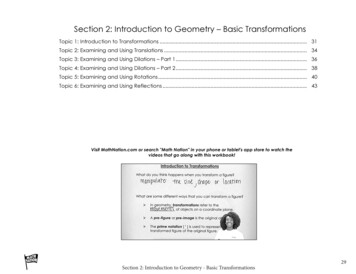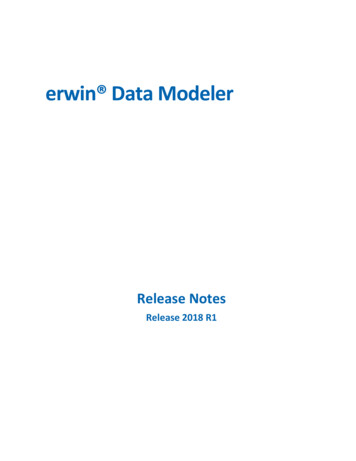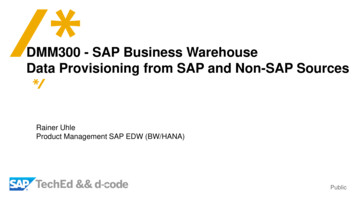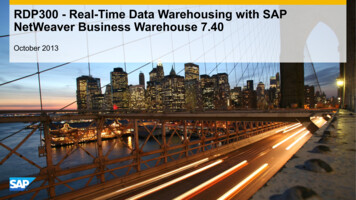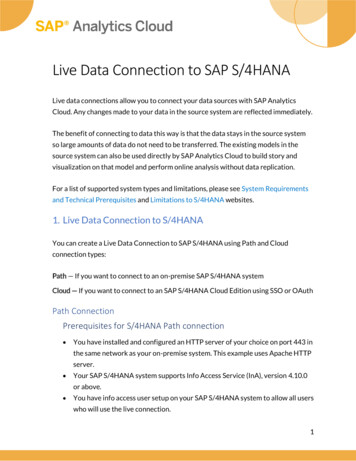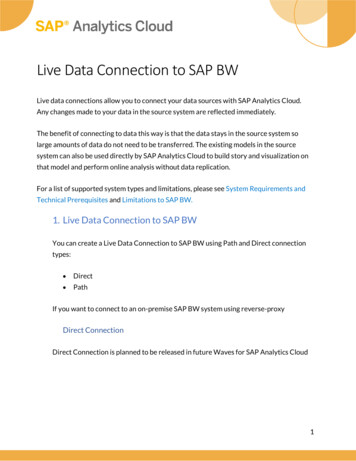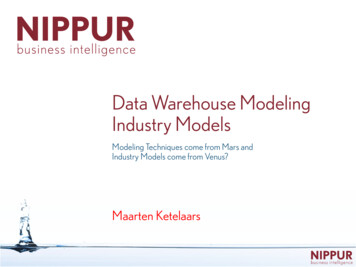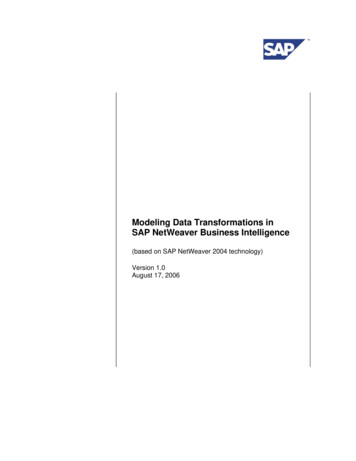
Transcription
Modeling Data Transformations inSAP NetWeaver Business Intelligence(based on SAP NetWeaver 2004 technology)Version 1.0August 17, 2006
Table of Contents:BI Data Transformation .31 General Do’s and Don’ts for BI Data Transformation.42 Data Transformation – Scenarios .52.1 Scenario 1: On-The-Fly Transformation .52.2 Scenario 2: Data Enrichment – Cross References .72.3 Scenario 3: Conditional Update .83 Conversion of Currencies and Units of Measure.113.1 Currency Conversion.113.2 Unit of measure conversion .164 Programming Routines.174.1 Start Routines.174.2 Standard Routines .184.3 Programming DDIC references .184.4 Monitor Messages .204.5 Error Handling .204.6 Encapsulate the coding for BI routines.215 Performance Aspects Related to BI Data Transformation.226 List of documents related to BI Data Transformation .22Modeling Data Transformations with BIPage 2
BI Data TransformationThe BI data transformation process enables you to consolidate, cleanse, and integrate data. You cansemantically synchronize data from heterogeneous sources. When you load data from one BI object into afurther BI object, the data is passed through a BI data transformation, which converts the fields of the sourceinto the format of the target.Figure 1: Data flow in BI systemsUp to release SAP NetWeaver 2004 there are two types of BI data transformations displayed in Figure 1: Transfer rulesTransfer rules specify how the data (key figures, time characteristics, characteristics) is transferred toInfoSources from the transfer structure of a DataSource. You are therefore connecting a DataSourcewith an InfoSource. Update rulesUpdate rules specify how the data (key figures, time characteristics, characteristics) is updated to datatargets (that is InfoProviders) from the communication structure of an InfoSource. You are thereforeconnecting an InfoSource with an InfoProvider.An update rule must be specified for each key figure and the corresponding characteristics of theInfoCube. For a DataStore object (also known as ODS object) it must be specified for the data and keyfields, and for an InfoObject it must be specified for the attribute and key fields.Important NoteAs of release SAP NetWeaver 2004s the concept of transfer and update rules is simplified by using a singleBI Content object type, simply called transformation. There, you create a transformation between a sourceand a target. The BI objects DataSource, InfoSource, DataStore object, InfoCube, InfoObject and InfoSetserve as source objects. The BI objects InfoSource, InfoObject, DataStore object and InfoCube serve astarget objects.While this document is based on SAP NetWeaver BI 2004, it is nevertheless of general interest because themain BI data modeling ideas remain the same across these two releases. Only Section 4 dealing withroutines (for example the start routine) in transformations will be modified when this document is updated forSAP NetWeaver BI 2004s.Modeling Data Transformations with BIPage 3
1 General Do’s and Don’ts for BI Data Transformation Generally, a data transformation should be performed within the BI system, if it is not necessary totransform the data already in the backend system. Business logic of the applications and application processes, which is needed for the dataextraction process itself, should be implemented in the DataSources. Transformations beside this (that is, the reporting logic) should be done on BI side. Quantity / currency / time conversions for reporting reasons should be done on BI side Use the generic transformation features like formula builder, time-, unit- and currency-conversion, masterdata read. [see section 2 and 3] Do not refer to generated DDIC structures like /BIC/*. Use dynamic coding instead. [see section 4.3] Do not aggregate or cumulate key figures in data packages of start routines if you can not make surethat all records with identical aggregation keys are in the same data package during the data upload.[see section 4.1] In general it is preferable to apply transformations as early as possible in order to reuse the data forseveral targets. Better use transfer rules (ONE transformation) if you have to transform data to severalInfoProviders (the same transformation for EACH InfoProvider). Try to avoid data transformation of business relevant data before updates to the (Enterprise) DataWarehouse Layer are performed. This is needed in order to get a 1:1 mapping between backend systemand (Enterprise) Data Warehouse Layer. Do not add new records to a data package during the update to an InfoProvider. Normally it is better tochange the data model to achieve the same results. Encapsulate your coding for routines [see section 4.6]Modeling Data Transformations with BIPage 4
2 Data Transformation – ScenariosThere are three main usages for data transformation in SAP NetWeaver BI:1. Modifications, enhancements, or grouping of the loaded records before writing them into theInfoProvider which will be used for the reporting afterwards.2. Conditional updates to the InfoProvider in order to make sure that only needed records will be writtento the InfoProvider.3. Transformation of unit, time, or currency-code related records to a uniform entity, which allows forintegrative reporting on all these records.As an overview of possible transformation scenarios, some of the most popular transformation scenarios willbe explained in this section.2.1Scenario 1: On-The-Fly TransformationThe easiest way to perform a data transformation during the update of an InfoProvider is to use the standardBI transformation features. You should use these transformations if you would like to perform simplecalculation for key figures on record level.ABAP routines should be used only if the transformation can not be done by using constants, currency/unitconversion or formulas.Scenario 1 : On-The-Fly Transformation- 1:1 Mapping- Constants- Currency/Unit Conversion- FormulaTransformation on record level by using standard transformation features of BI.No master data or InfoProvider read. SAP AG 2003, Title of Presentation, Speaker Name / 1Figure 2: On-the-fly transformationModeling Data Transformations with BIPage 5
2.1.1ConstantsIf a characteristic or key figure should have a constant value for every record, then it is not necessary tocreate your own ABAP routine to assign this constant value to the InfoObject. In the transfer rules you havethe opportunity to assign constants directly to InfoObjects.2.1.2 Currency / Unit ConversionFor enterprise wide reporting it is often necessary to adjust reporting objects to uniform units of measure andcurrency codes. This conversion can be done during data upload into the InfoProvider or during queryexecution. Please have a look at Section 3 for a detailed explanation of the different conversion possibilities.2.1.3FormulaFormulas are the best and easiest way to do on-the-fly transformations of single records for specific keyfigures or characteristics.You can assign a formula to an InfoObject and use this formula in the update rules or transfer rules. With thehelp of the formula builder you can calculate new values for key figures or implement simple conditionalupdates with IF-statements. For calculation or IF-statements, all values in the fields/InfoObjects that make upthe communication structure or transfer structure (if the formula will be created in an update rule or a transferrule, respectively) can be used.In the example below, the key figure 0ORA COUNT gets the value “0”, if 0PSTNG DATE (Posting Date) isolder than 01.01.2000. If not, 0ORA COUNT gets the value “1” for the current record.Scenario 1 : On-The-Fly Transformation - Formula SAP AG 2003, Title of Presentation, Speaker Name / 2Figure 3: On-the-fly transformation – FormulaModeling Data Transformations with BIPage 6
Formula versus RoutineFormulas are very easy to read for customers and other SAP colleagues. The transformation process ismore transparent to the power user.2.2Scenario 2: Data Enrichment – Cross ReferencesSometimes not all of the values needed for a data update to an InfoProvider are provided by thecommunication structure, but the values do already exist in the BI system.If so, it is possible to enrich the values coming from the communication structure by reading the necessaryvalues from other InfoProviders or master data tables.Scenario 2 : Data Enrichment – Cross ReferencesMaster Data ReadInfoProvider Read(Self)InfoProvider Read SAP AG 2003, Title of Presentation, Speaker Name / 1Figure 4: Data Enrichment - Cross ReferencesPerformance IssuesYou should remember that data load performance will decrease if you cross reference data from otherInfoProviders during the upload process.For example, if a simple database read such as:Select single FIELD from DB TABLE into WA where DB FIELD1 ”XYZ”takes 10 milliseconds, then the data upload time will increase by 16 minutes for a full upload of 100.000records and it goes from bad to worse if you must upload 1 million records. See the table below.db read time forsingle recordin mscount ofrecordsModeling Data Transformations with BIextra upload timein minutesPage 7
67This of course is a rough example that does not take buffering, indexes, or other considerations into account.Still, you can see the potential impact that cross-references can have on upload performance.2.2.1 Master Data ReadA simple master data read should be done using generic BI functionality in the update rules. Choose theoption “Master Data Attribute of” in the update rule details for the selected characteristic and select anattribute by using the F4 help. With this setting, the value of the characteristic to be updated is read from themaster data table of the specified characteristic.Example: Characteristic Material is provided by the InfoSource.Characteristic Material Group is not provided by the InfoSource.Characteristic Material Group is an attribute of characteristic Material.Therefore you can fill Material Group from the master data table of Material: Select the method “Master DataAttribute from” and Material as source.The generic master data read only works for characteristics that are available in the communicationstructure.For a more complex master data read or if the characteristic is not available in the communication structure,you have to implement the master data read yourself in a routine for the specific characteristic. If so, thefunction module RSAU READ MASTER DATA should be used to read the master data.2.2.2 InfoProvider ReadThere is no generic BI functionality for a read from an InfoProvider. Therefore you have to implement ityourself in the update rules in the routine of the specific InfoObject. Normally the function moduleRSDRI INFOPROV READ should be used to read data from InfoProviders.It is often quicker and easier to implement a select to the corresponding DataStore object table instead ofusing the function module, especially when reading from DataStore objects (formerly known as ODSobjects). The DataStore object table is generated if the DataStore object is created. The name of theDataStore object table follows a naming convention. For DataStore object 0SRPO D1 the name of thecorresponding table is /BI0/ASRPO D100./BI0/ASRPO D100 Prefix for generated DataStore object tables Name of the DataStore object without leading zero Suffix for active records (suffix 40 and 50 inactive and change log are also available)Note:It is not recommended to program a select statement directly with regard to the generated DataStore objecttables, because these DDIC objects exist only after BI Content activation. The select must be implementedwith dynamic coding. Please see Section 4.3 for details.Please make sure that you read the active data of the InfoProvider and master data with each read.Otherwise you will run into data inconsistency problems.2.3 Scenario 3: Conditional UpdateYou program a conditional update if you want to filter out data records that fulfill certain conditions before youperform the upload into the final InfoProvider. This filter must be implemented manually in the start routine ofthe update rule.Modeling Data Transformations with BIPage 8
Scenario 3 : Conditional UpdateCommunicationStructure ValueStart routinewith conditionif OkMaster Data ReadInfoProvider ReadIn the start routine of the update rule or transfer rule conditions for an update to theInfoProvider on record level can be defined. Master data read or InfoProvider read couldbe additionally necessary if not all needed values for the condition are provided by thecommunication structure. SAP AG 2003, Title of Presentation, Speaker Name / 1Figure 5: Conditional Update2.3.1 Delete Data PackageIf records fulfilling certain conditions should not be updated to the final InfoProvider at all, the records can bedeleted in the update rule. The deletion on record level must be done in the start routine of the update rule. Aconditional update by deleting records could look like this:Loop at DATA PACKAGE.l days open sy-datum - DATA PACKAGE-PLDDELDATE.If DATA PACKAGE-STSPP COMP 'X' or l days open 0.delete DATA PACKAGE.Endif.Endloop.All records of the current data package are stored in the internal table DATA PACKAGE. This is doneautomatically by the update rule framework. The table structure is equal to the communication structure.During the loop through all records of the current data package the condition can be defined. If the conditionis fulfilled the current record will be deleted out of the internal table DATA PACKAGE.An update to the InfoProvider will be performed for the records in the internal table DATA PACKAGE only.This is an easy example for a conditional update. Please have a look at Section 4 for more complexexamples.Modeling Data Transformations with BIPage 9
2.3.2 Record modeApart from deleting records in the update rules it could make sense to manipulate the value of thecharacteristic 0RECORDMODE. The record mode will be taken into account during the data activation in aDataStore object. Depending on the value of 0RECORDMODE, values will be added, deleted, or cumulatedin the DataStore object.By using the different recordmode types you can influence the update behavior as follows.' ': The record delivers an after image.The status is transferred after something is changed or added. You can update the record into anInfoCube only if the corresponding before image exists in the request.'X': The record delivers a before imageThe record reflects the status before the data change.All record attributes that can be aggregated have to be transferred with a reverse /- sign. Thereversal of the sign is carried out either by the extractor (default) or the Service API. In this case, theindicator 'Field is inverted in the cancellation field' must be set for the relevant extraction structurefield in the DataSource.These records are ignored if the update is a non-additive update of a DataStore object.The before image is complementary to the after image.'D': The record has to be deleted.Only the key is transferred. This record (and its DataSource) can only be updated into a DataStoreobject.'R': The record delivers a reverse image.The content of this record is the same as the content of a before image. The only difference is with aDataStore object update: Existing records with the same key are deleted.A conditional update by using the Recordmode could look like this.LOOP AT DATA PACKAGE.IF DATA PACKAGE-lw gists EQ 'C' OR DATA PACKAGE-sched del EQ 'X'.MOVE 'R' TO DATA PACKAGE-recordmode.MODIFY DATA PACKAGE.ENDIF.ENDLOOP.Modeling Data Transformations with BIPage 10
3 Conversion of Currencies and Units of Measure3.1Currency ConversionIn SAP systems, every amount key figure is stored with respect to a currency key field. There are severaltypes of currency keys on OLTP data. The two most important currency types are the document (ortransaction) currency (BI InfoObject 0DOC CURRCY) and the local (or company code) currency (BIInfoObject 0LOC CURRCY. The document currency is entered for each posting transaction of an OLTPdocument-type record (for example financial documents), whereas the local currency is uniquely assigned toa company code when the OLTP system is customized.So, the local currency can be used as a common currency for cross-application BI reporting (that is acommon reporting currency). Besides the document currency, every record within the final InfoProviders ofthe BI system should contain the local currency and the corresponding amounts with respect to the localcurrency.There are different scenarios for the currency conversion of source system data:1. No conversion necessaryThe source system tables contain amounts with respect to both currency types (document and localcurrency). The currency conversion was already done at the time when the document was posted intothe database of the OLTP system. In this case, the extractor should read local and document currencies(amounts and currency keys) and transfer them to the extract structure of the DataSource. No furthercurrency conversion to local currency should take place neither in the OLTP extractor nor in the BIupdate rules.This is the case for FI / CO documents.2. Currency conversion in BI update rulesIf the local currency (amounts and currency key) cannot be provided by the DataSource from OLTPtables, the currency conversion has to take place at data upload time. Currency conversion in updaterules provides the option of translating data records from the source currency (document currency) of theInfoSource into a target currency (local currency) in the InfoProviders.The currency conversion in a BI update rule uses a pre-defined currency conversion type of the BIContent or it uses hard-coded routines, if necessary.For DataStore objects it is not possible to execute the currency conversion by using predefined currencyconversion types. Instead, you have to revert to routines.Example for update ruleSource InfoObjects: 0DEB CRE DC 0DOC CURRCYTarget InfoObjects: 0DEB CRE LC 0LOC CURRCYCurrency translation type:Amount in Document CurrencyDocument CurrencyAmount in Local CurrencyLocal CurrencyAverage Rate for Current DateModeling Data Transformat
Business logic of the applications and application processes, which is needed for the data extraction process itself, should be implemented in the DataSources. Transformations beside this (that is, the reporting logic) should be done on BI side. Quantity / currency / time co


